- Accueil
- Pages cachées
- 12 AVRIL 2024 NEWS
12 AVRIL 2024 NEWS
INSTITUT SUPERIEUR D'ANTHROPOLOGIE
INSTITUT OF ANTHROPOLOGY
COURS ONLINE – COURS A DISTANCE
INSCRIPTIONS OUVERTES
REGISTER NOW
ITALIE – 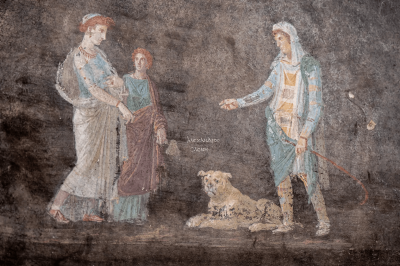
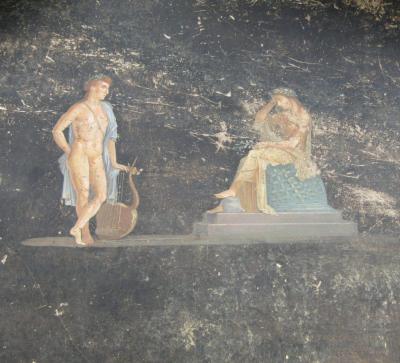 Pompéi - Archeologists have uncovered remarkably preserved ‘fresco’ paintings on a wall in the banqueting room of a large house along Via di Nola, one of Pompeii’s longest streets. In a recently excavated area of the ancient Roman city of Pompeii, archaeologists have discovered exquisitely preserved frescoes in the banqueting hall known as the “Black Room.” It’s being called the black room because it was painted black, likely to mask soot from oil lamps that would have burnt. Conversely, the room’s mosaic floor is comprised of more than a million tiny and intricately arranged white tiles. The two frescoes, which are painted on the hall’s walls, show scenes from Greek mythology and literature. One of the stunning artworks depicts Helen of Troy, a beautiful woman in Greek mythology, meeting Paris, the prince of Troy, for the first time. According to legend, the resulting elopement between the two sparked the Trojan War. The second fresco depicts the Trojan priestess Cassandra seated, while the god Apollo, one arm resting on a lyre, attempts to seduce her. When she rejects the god, he dooms her to proclaim prophecies that will never be believed. The “Black Room” is only a portion of a larger home that archaeologists have been excavating for a year. It was discovered inside a residential and commercial district known as Region Nine. The house featured a garden and reception room; next door was a bakery where skeletons and a shrine had been discovered; next to the bakery was a laundry. Archaeologists suspect that these three areas—the house, bakery, and laundry—were owned by the same person. They have also found the initials “ARV” on walls and millstones. “We know who ARV is: he’s Aulus Rustius Verus,” the archaeological park of Pompeii archaeologist Sophie Hay told the BBC. “We know him from other political propaganda in Pompeii. He’s a politician. He’s super-rich. We think he may be the one who owns the posh house behind the bakery and the laundry.”
Pompéi - Archeologists have uncovered remarkably preserved ‘fresco’ paintings on a wall in the banqueting room of a large house along Via di Nola, one of Pompeii’s longest streets. In a recently excavated area of the ancient Roman city of Pompeii, archaeologists have discovered exquisitely preserved frescoes in the banqueting hall known as the “Black Room.” It’s being called the black room because it was painted black, likely to mask soot from oil lamps that would have burnt. Conversely, the room’s mosaic floor is comprised of more than a million tiny and intricately arranged white tiles. The two frescoes, which are painted on the hall’s walls, show scenes from Greek mythology and literature. One of the stunning artworks depicts Helen of Troy, a beautiful woman in Greek mythology, meeting Paris, the prince of Troy, for the first time. According to legend, the resulting elopement between the two sparked the Trojan War. The second fresco depicts the Trojan priestess Cassandra seated, while the god Apollo, one arm resting on a lyre, attempts to seduce her. When she rejects the god, he dooms her to proclaim prophecies that will never be believed. The “Black Room” is only a portion of a larger home that archaeologists have been excavating for a year. It was discovered inside a residential and commercial district known as Region Nine. The house featured a garden and reception room; next door was a bakery where skeletons and a shrine had been discovered; next to the bakery was a laundry. Archaeologists suspect that these three areas—the house, bakery, and laundry—were owned by the same person. They have also found the initials “ARV” on walls and millstones. “We know who ARV is: he’s Aulus Rustius Verus,” the archaeological park of Pompeii archaeologist Sophie Hay told the BBC. “We know him from other political propaganda in Pompeii. He’s a politician. He’s super-rich. We think he may be the one who owns the posh house behind the bakery and the laundry.”
DANEMARK - 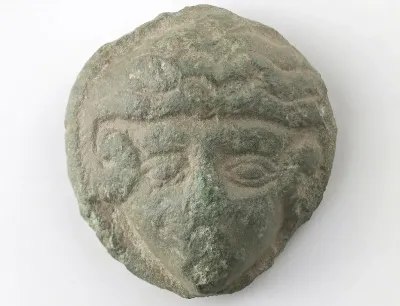 Ringsted - Two amateur archaeologists have made a unique find near Ringsted in the Danish island of Zealand. A sign that one of history’s greatest warlords was known in these parts. A bronze fitting with a portrait of Alexander the Great was found. The 26-28 mm diameter (small) fitting is cast in a lead-containing bronze alloy. This represents Alexander the Great, who is easily recognized by the wavy locks of hair and ram’s horns by the ears (which he has after the god Zeus Ammon). Archaeologists do not know exactly the function of Ringsted’s bronze fitting: the function of the bracket – was it a decorative disc for the shield, or was it a sword (belt) bracket? Was it cast by the Romans, who used the same lead-containing alloy for casting statuettes, was it cast by the Romans from a remelted statuette or did the remelting take place on Zealand? If the bracket was cast by the Romans, how did it end up in a field near Ringsted? What was the meaning of Alexander the Great’s portrait for the Germans who lived in Denmark around the year 200? Did they think the portrait could bring luck on the battlefield? The multiplicity of questions increases the beauty and unique value of the find and undoubtedly excites the experts to unravel the veil of mystery surrounding it.
Ringsted - Two amateur archaeologists have made a unique find near Ringsted in the Danish island of Zealand. A sign that one of history’s greatest warlords was known in these parts. A bronze fitting with a portrait of Alexander the Great was found. The 26-28 mm diameter (small) fitting is cast in a lead-containing bronze alloy. This represents Alexander the Great, who is easily recognized by the wavy locks of hair and ram’s horns by the ears (which he has after the god Zeus Ammon). Archaeologists do not know exactly the function of Ringsted’s bronze fitting: the function of the bracket – was it a decorative disc for the shield, or was it a sword (belt) bracket? Was it cast by the Romans, who used the same lead-containing alloy for casting statuettes, was it cast by the Romans from a remelted statuette or did the remelting take place on Zealand? If the bracket was cast by the Romans, how did it end up in a field near Ringsted? What was the meaning of Alexander the Great’s portrait for the Germans who lived in Denmark around the year 200? Did they think the portrait could bring luck on the battlefield? The multiplicity of questions increases the beauty and unique value of the find and undoubtedly excites the experts to unravel the veil of mystery surrounding it.
CHINE – 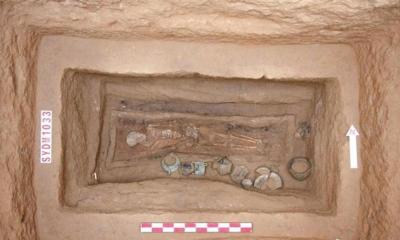
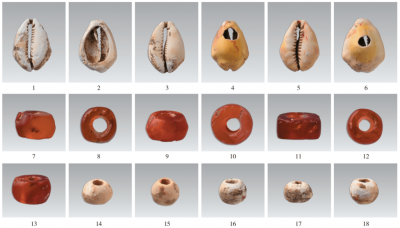
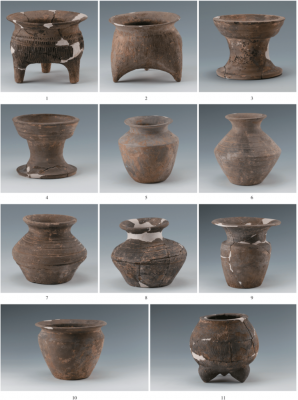
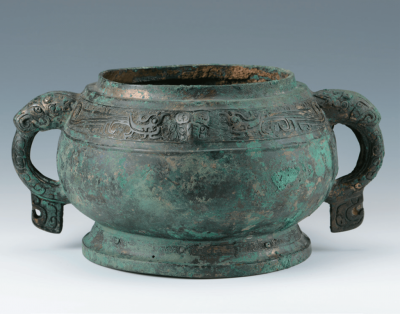 Dahekou - A tomb belonging to a noblewoman dating back about 3,000 years has been unearthed in North China’s Shanxi Province. The tomb, designated as M1033, was discovered in the Dahekou cemetery, Yicheng County. Over 600 burials and 20 chariot-and-horse pits have been discovered during the excavation of the Western Zhou Dynasty’s Dahekou Cemetery in Yicheng County, Shanxi Province, since 2007. More importantly, the finding of the Dahekou cemetery has shed light on the existence of the Ba state, previously undocumented in the historical texts of the Western Zhou. Bronze inscriptions found in Dahekou cemetery indicate that the state clan name was Ba 霸, with Ba Bo (the Earl of Ba) as the paramount ruler.The discovery was announced by the Shanxi Institute of Cultural Relics and Archeology. A pit in the middle holds the remains of a sacrificed animal, and the tomb itself is medium-sized, according to Xie Yaoting, the leader of the archaeological team. The tomb’s owner was a female between 31 and 34 years old who was buried in a supine posture with straight limbs. Archaeologists believe that the tomb’s owner was likely a middle-ranking noblewoman from the mid-Western Zhou (1046BC-771BC) period. The tomb yielded a collection of 430 burial objects divided into 93 groups, including bronze wares, pottery, jade artifacts, and shellfish containers.
Dahekou - A tomb belonging to a noblewoman dating back about 3,000 years has been unearthed in North China’s Shanxi Province. The tomb, designated as M1033, was discovered in the Dahekou cemetery, Yicheng County. Over 600 burials and 20 chariot-and-horse pits have been discovered during the excavation of the Western Zhou Dynasty’s Dahekou Cemetery in Yicheng County, Shanxi Province, since 2007. More importantly, the finding of the Dahekou cemetery has shed light on the existence of the Ba state, previously undocumented in the historical texts of the Western Zhou. Bronze inscriptions found in Dahekou cemetery indicate that the state clan name was Ba 霸, with Ba Bo (the Earl of Ba) as the paramount ruler.The discovery was announced by the Shanxi Institute of Cultural Relics and Archeology. A pit in the middle holds the remains of a sacrificed animal, and the tomb itself is medium-sized, according to Xie Yaoting, the leader of the archaeological team. The tomb’s owner was a female between 31 and 34 years old who was buried in a supine posture with straight limbs. Archaeologists believe that the tomb’s owner was likely a middle-ranking noblewoman from the mid-Western Zhou (1046BC-771BC) period. The tomb yielded a collection of 430 burial objects divided into 93 groups, including bronze wares, pottery, jade artifacts, and shellfish containers.
FRANCE – 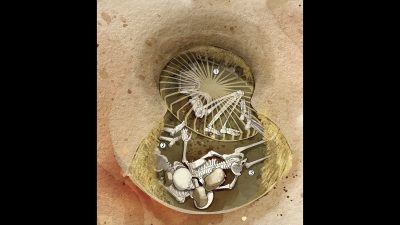
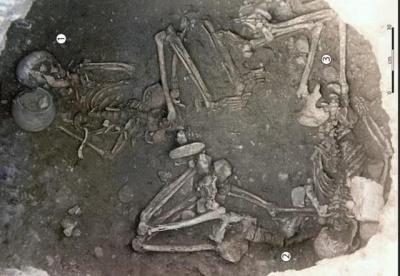 Saint-Paul-Trois-Châteaux - The study follows a reevaluation of an old tomb found in southern France’s Saint-Paul-Trois-Châteaux, close to Avignon, more than 20 years ago. Two women who were buried there approximately 5,500 years ago are buried in a tomb that resembles a silo, or pit used to store grain. Researchers started by studying skeletons excavated at Saint-Paul-Trois-Châteaux, a Neolithic tomb. Three of the remains belonged to women that the team determined were forced into positions that caused them to asphyxiate; at least one of the women may have been buried alive The team then scoured existing studies for similar cases of unusual burial practices in Stone Age Europe with abnormally positioned bodies. Archaeologists sought more evidence to ascertain whether the women’s deaths, though clearly violent, were part of a larger Neolithic tradition that was probably connected to agricultural practices. They then assessed existing anthropological and archaeological literature and found reports from 14 sites across Eastern Europe to Catalonia of similar burials. Additionally, rock art from Sicily dating back to the even earlier Mesolithic period (Middle Stone Age) appears to depict figures bound in a similar manner. Further investigation found that squeezing the breath out of people was already a ritualized form of homicide for 2,000 years by the time the Rhône Valley victims died between 6,000 and 5,500 years ago. The study highlights the presence of agricultural symbolism surrounding the tomb. This suggests the sacrifice might have been linked to agricultural practices during the Neolithic period (New Stone Age). “The principal challenge in archaeology, especially in prehistory where written records are absent, is distinguishing ritual sacrifice from other forms of ritualized violence,” the study authors wrote. Their research is published today in Science Advances. According to researchers, the practice of killing probably began as a sacrificial custom before agriculture, and it was later employed for human sacrifices connected to farming in the Neolithic era. This discovery offers a glimpse into a dark aspect of Neolithic European societies and their ritualistic practices. The study’s findings raise further questions about the motivations behind these sacrifices and their connection to the development of agriculture.
Saint-Paul-Trois-Châteaux - The study follows a reevaluation of an old tomb found in southern France’s Saint-Paul-Trois-Châteaux, close to Avignon, more than 20 years ago. Two women who were buried there approximately 5,500 years ago are buried in a tomb that resembles a silo, or pit used to store grain. Researchers started by studying skeletons excavated at Saint-Paul-Trois-Châteaux, a Neolithic tomb. Three of the remains belonged to women that the team determined were forced into positions that caused them to asphyxiate; at least one of the women may have been buried alive The team then scoured existing studies for similar cases of unusual burial practices in Stone Age Europe with abnormally positioned bodies. Archaeologists sought more evidence to ascertain whether the women’s deaths, though clearly violent, were part of a larger Neolithic tradition that was probably connected to agricultural practices. They then assessed existing anthropological and archaeological literature and found reports from 14 sites across Eastern Europe to Catalonia of similar burials. Additionally, rock art from Sicily dating back to the even earlier Mesolithic period (Middle Stone Age) appears to depict figures bound in a similar manner. Further investigation found that squeezing the breath out of people was already a ritualized form of homicide for 2,000 years by the time the Rhône Valley victims died between 6,000 and 5,500 years ago. The study highlights the presence of agricultural symbolism surrounding the tomb. This suggests the sacrifice might have been linked to agricultural practices during the Neolithic period (New Stone Age). “The principal challenge in archaeology, especially in prehistory where written records are absent, is distinguishing ritual sacrifice from other forms of ritualized violence,” the study authors wrote. Their research is published today in Science Advances. According to researchers, the practice of killing probably began as a sacrificial custom before agriculture, and it was later employed for human sacrifices connected to farming in the Neolithic era. This discovery offers a glimpse into a dark aspect of Neolithic European societies and their ritualistic practices. The study’s findings raise further questions about the motivations behind these sacrifices and their connection to the development of agriculture.
Stone Age women in Europe were tied up and buried alive in ritual sacrifices - Arkeonews
CHINE – 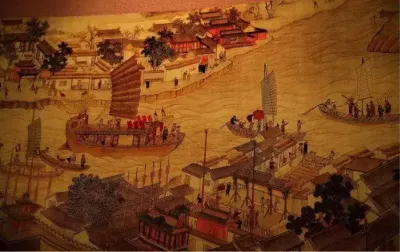 Hebei - Archaeologists have discovered a total of 85 ancient sites from the Sui Dynasty (581-618) and later periods in the Hengshui section of the Grand Canal, according to the Hebei provincial institute of cultural relics and archaeology. This was reported by The Xinhua News Agency. According to Hu Qiang, an archaeologist at the institute, the archaeological survey spanned 350 square kilometers, uncovering 85 ancient sites. These sites included remnants of ancient cities, villages, residential structures, tombs, handicraft industries, and traces of water transportation. Among the archaeological finds, the ancient city sites along the Grand Canal could date back to the dynasties of Tang and Song (618-1279), which indicates that several regional central cities had formed around the Grand Canal in ancient China. Notably, the ancient Gonggao city site unearthed by the archaeological team in Fucheng County is the highest-level Tang Dynasty urban site found in this archaeological survey. Shi Jinju, director of the county-level cultural relics protection institute, said that Gonggao was established as the seat of government of Guanzhou and Jingzhou during the Tang Dynasty. The existing remnants of the southern city wall cover a length of 400 meters from east to west and 20 meters from north to south. The site contains rich artifacts, including fragments of bricks, tiles, pottery and porcelain. With a history of more than 2,500 years, the Grand Canal, connecting Beijing and Hangzhou in east China's Zhejiang Province, served as a significant transportation artery in ancient China.
Hebei - Archaeologists have discovered a total of 85 ancient sites from the Sui Dynasty (581-618) and later periods in the Hengshui section of the Grand Canal, according to the Hebei provincial institute of cultural relics and archaeology. This was reported by The Xinhua News Agency. According to Hu Qiang, an archaeologist at the institute, the archaeological survey spanned 350 square kilometers, uncovering 85 ancient sites. These sites included remnants of ancient cities, villages, residential structures, tombs, handicraft industries, and traces of water transportation. Among the archaeological finds, the ancient city sites along the Grand Canal could date back to the dynasties of Tang and Song (618-1279), which indicates that several regional central cities had formed around the Grand Canal in ancient China. Notably, the ancient Gonggao city site unearthed by the archaeological team in Fucheng County is the highest-level Tang Dynasty urban site found in this archaeological survey. Shi Jinju, director of the county-level cultural relics protection institute, said that Gonggao was established as the seat of government of Guanzhou and Jingzhou during the Tang Dynasty. The existing remnants of the southern city wall cover a length of 400 meters from east to west and 20 meters from north to south. The site contains rich artifacts, including fragments of bricks, tiles, pottery and porcelain. With a history of more than 2,500 years, the Grand Canal, connecting Beijing and Hangzhou in east China's Zhejiang Province, served as a significant transportation artery in ancient China.
85 ancient sites unearthed along China's Grand Canal | Ukrainian news (ukranews.com)
ISRAEL – 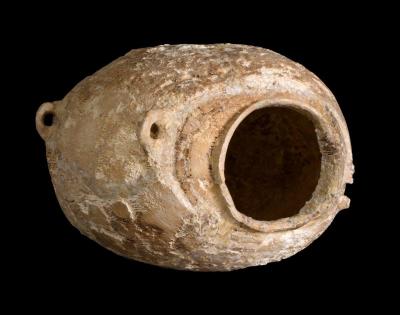 Beersheba - A recent excavation near Beersheba in southern Israel uncovered an ivory vessel crafted of elephant tusks dating to the Chalcolithic period (around 4,000 BC). The find is the first Chalcolithic ivory vessel discovered in Israel. The vessel is of a type known to researchers as an amphoriskos, a small jar. This rare find sheds light on ancient trade connections between the Holy Land and Egypt some six millennia ago The diameter of the ivory container is approximately 8 inches. Its exquisitely designed and skillfully crafted small matching handles are arranged symmetrically around its lower body and neck. The find is the first Chalcolithic ivory vessel discovered in Israel, the Israel Antiquities Authority (IAA) said and was likely either imported from Egypt or carved locally from ivory imported from there. The rare item was discovered in 2020 at Horvat Raqiq, an archaeological site near Beersheba in southern Israel, during infrastructure work to lay a water pipe, the IAA told The Times of Israel. More than just artifacts were discovered during the excavation at Horbat Raqiq; it also uncovered an old settlement with underground buildings etched into the Loess ground. Emil Aladjem discovered the edge of a basalt vessel during the last stages of the dig, which prompted additional investigation. Three imposing vessels were found within the excavation site after an extended search. Among them, nestled within layers of soil, lay the shattered remnants of the ivory vessel, carefully interred in antiquity – a testament to its significance.
Beersheba - A recent excavation near Beersheba in southern Israel uncovered an ivory vessel crafted of elephant tusks dating to the Chalcolithic period (around 4,000 BC). The find is the first Chalcolithic ivory vessel discovered in Israel. The vessel is of a type known to researchers as an amphoriskos, a small jar. This rare find sheds light on ancient trade connections between the Holy Land and Egypt some six millennia ago The diameter of the ivory container is approximately 8 inches. Its exquisitely designed and skillfully crafted small matching handles are arranged symmetrically around its lower body and neck. The find is the first Chalcolithic ivory vessel discovered in Israel, the Israel Antiquities Authority (IAA) said and was likely either imported from Egypt or carved locally from ivory imported from there. The rare item was discovered in 2020 at Horvat Raqiq, an archaeological site near Beersheba in southern Israel, during infrastructure work to lay a water pipe, the IAA told The Times of Israel. More than just artifacts were discovered during the excavation at Horbat Raqiq; it also uncovered an old settlement with underground buildings etched into the Loess ground. Emil Aladjem discovered the edge of a basalt vessel during the last stages of the dig, which prompted additional investigation. Three imposing vessels were found within the excavation site after an extended search. Among them, nestled within layers of soil, lay the shattered remnants of the ivory vessel, carefully interred in antiquity – a testament to its significance.
A rare 6,000-year-old elephant ivory vessel was unearthed near Beersheba - Arkeonews
POLOGNE – 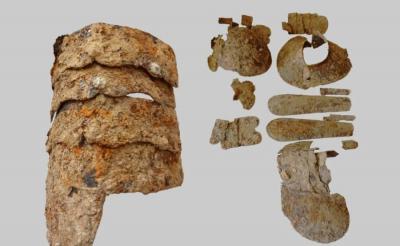 Mikułowice - A 17th-century Hussar armor was found in a field in the village of Mikułowice in the Opatów region in southeastern Poland. Unexpectedly in good condition, the armor recalls a fascinating period of European history in Poland and beyond. The armor sat just two feet beneath the surface for more than three centuries (about 60cm). Hussars were light cavalry mounted on fast horses. The hussars were skilled riders who were chosen from the wealthiest nobility in Poland. They were well-known for the enormous “wings” that they either wore on their backs or fastened to their saddles. Eagle feathers were inserted into the back rims of wooden wing-shaped frames to create these wings. During a charge, the thunderous noise produced by the flapping of these extra appendages was intended to startle the enemy horses. Known as “winged horsemen,” the colorfully costumed hussars also wore leopard or similar animal skins in the style of cloaks over the pauldrons (shoulder pieces) of their armor. “The armor is incomplete, the basic element of the cuirass is missing, consisting of a breastplate and a backplate, which served to protect the chest and back, and one of the shoulder pads,” Dr. Hab. Marek Florek from the Sandomierz branch of the Provincial Office for the Protection of Monuments, explained. “The left shoulder pad, both bracers protecting the forearm, and a semicircular helmet, i.e. a helmet with two so-called cheeks and the so-called clavicle protecting the neck and nape.” The armor lacks decorative elements, indicating that it was made locally, most likely on the orders of a local nobleman. Researchers believe it dates back to the 17th century. “Based on the shape of the helmet, we can estimate with high probability that [the armor] comes from the first half of the 17th century,” a researcher from Maria Curie-Skłodowska University (UMCS) explained in the press release. “It is a bit corroded, and we will only be more certain about its date of creation after conservation work.”
Mikułowice - A 17th-century Hussar armor was found in a field in the village of Mikułowice in the Opatów region in southeastern Poland. Unexpectedly in good condition, the armor recalls a fascinating period of European history in Poland and beyond. The armor sat just two feet beneath the surface for more than three centuries (about 60cm). Hussars were light cavalry mounted on fast horses. The hussars were skilled riders who were chosen from the wealthiest nobility in Poland. They were well-known for the enormous “wings” that they either wore on their backs or fastened to their saddles. Eagle feathers were inserted into the back rims of wooden wing-shaped frames to create these wings. During a charge, the thunderous noise produced by the flapping of these extra appendages was intended to startle the enemy horses. Known as “winged horsemen,” the colorfully costumed hussars also wore leopard or similar animal skins in the style of cloaks over the pauldrons (shoulder pieces) of their armor. “The armor is incomplete, the basic element of the cuirass is missing, consisting of a breastplate and a backplate, which served to protect the chest and back, and one of the shoulder pads,” Dr. Hab. Marek Florek from the Sandomierz branch of the Provincial Office for the Protection of Monuments, explained. “The left shoulder pad, both bracers protecting the forearm, and a semicircular helmet, i.e. a helmet with two so-called cheeks and the so-called clavicle protecting the neck and nape.” The armor lacks decorative elements, indicating that it was made locally, most likely on the orders of a local nobleman. Researchers believe it dates back to the 17th century. “Based on the shape of the helmet, we can estimate with high probability that [the armor] comes from the first half of the 17th century,” a researcher from Maria Curie-Skłodowska University (UMCS) explained in the press release. “It is a bit corroded, and we will only be more certain about its date of creation after conservation work.”
Hussar Armor From The 17th Century Found By Metal Detectorist In Poland - Arkeonews
IRAN – 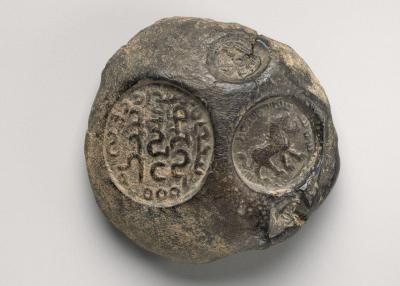 Sharaz - In a stunning archaeological find, the name “Shiraz” was identified on a clay sealing from the Sassanid era written in Pahlavi script. The finding is important due to cementing the history of Shiraz, which is situated some 60 km south of Persepolis, once the ceremonial capital of the Achaemenid Empire (c. 550–330 BC). The sealing is being kept at the Metropolitan Museum of Art in New York. These sealings were unearthed during three seasons of archaeological excavations by experts from the Metropolitan Museum of Art, conducted from 1932 to 1935. According to the Met Museum, this sealing was impressed with four seals of varying sizes. The imagery on the seals depicts a lion walking right, a monogram, an inscription, and a horned quadruped. This sealing was one of more than five hundred that were unearthed from the Sasanian stronghold located at Qasr-e Abu Nasr. The building burned, baking the clay and preserving the seal impressions, which is how the cache survived. Iranian archaeologist Mohammadreza Nasab-Abdollahi said that based on the research he has done, he has identified the name of Shiraz in the Pahlavi script (Middle Persian) on the “Sasanian clay seal”, which were obtained nearly a century ago from the archaeological excavations in the “Qasr-e Abu Nasr” in the east of Shiraz. On 6 April, Iranian archaeologist Mohammadreza Nasab-Abdollahi affirmed to ISNA news agency that the inscription “Mugh-e Shiraz” has been deciphered on these Sassanid clay sealings.
Sharaz - In a stunning archaeological find, the name “Shiraz” was identified on a clay sealing from the Sassanid era written in Pahlavi script. The finding is important due to cementing the history of Shiraz, which is situated some 60 km south of Persepolis, once the ceremonial capital of the Achaemenid Empire (c. 550–330 BC). The sealing is being kept at the Metropolitan Museum of Art in New York. These sealings were unearthed during three seasons of archaeological excavations by experts from the Metropolitan Museum of Art, conducted from 1932 to 1935. According to the Met Museum, this sealing was impressed with four seals of varying sizes. The imagery on the seals depicts a lion walking right, a monogram, an inscription, and a horned quadruped. This sealing was one of more than five hundred that were unearthed from the Sasanian stronghold located at Qasr-e Abu Nasr. The building burned, baking the clay and preserving the seal impressions, which is how the cache survived. Iranian archaeologist Mohammadreza Nasab-Abdollahi said that based on the research he has done, he has identified the name of Shiraz in the Pahlavi script (Middle Persian) on the “Sasanian clay seal”, which were obtained nearly a century ago from the archaeological excavations in the “Qasr-e Abu Nasr” in the east of Shiraz. On 6 April, Iranian archaeologist Mohammadreza Nasab-Abdollahi affirmed to ISNA news agency that the inscription “Mugh-e Shiraz” has been deciphered on these Sassanid clay sealings.
Name of Iranian city identified on 1800-year-old Sassanid clay seal - Arkeonews
AUSTRALIE –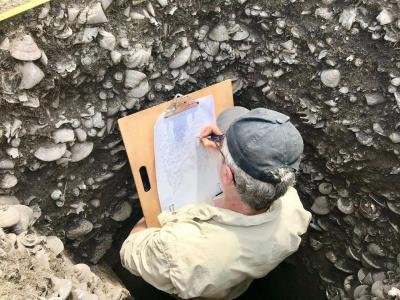 Lizard - More than 2000 years ago, Aboriginal Australians were producing ceramics on a secluded island about 35 kilometers off the coast of Queensland. This discovery of the oldest pottery in Australia has challenged “colonialist stereotypes” according to researchers. Archaeologists found 82 pieces of pottery shards dating between 2000 and 3000 years old on the Lizard Island Group (Jiigurru), off the Far North Queensland coast. Archaeologists excavated the 2.4-meter-deep midden over two years to discover evidence of occupation, such as the remains of shellfish and fish collected and eaten by people on the island. Less than a meter below the surface, the team found dozens of pottery sherds dating between 2000 and 3000 years old—the oldest pottery ever discovered in Australia. The site provides evidence of human habitation for about 6,000 years, revealing Jiigurru as the earliest known offshore island occupied on the northern Great Barrier Reef. Pottery fragments are the earliest securely dated, locally produced pottery found in Australia that pre-dates the arrival of Europeans. This discovery overturns the long-held belief that the first Australians did not produce ceramics or did not have the maritime technology to produce ceramics for long periods. In their paper in the journal Quaternary Science Reviews, the researchers argue that the discovery shows that Aboriginal people on Jiigurru (Lizard Island) were not only aware of pottery thousands of years before European colonization but were making it themselves. “The thin-walled sherds could indicate that the vessels [are] plain globular pots, with either everted rim or out curving rim, which usually thicken at the rim/neck/shoulder and gradually thin toward the base.“However, as the sample size is quite small and the pieces highly fragmented, this would need further investigation to confirm.” “We estimate the orifice of one is a little more than 20 cm, however, given the rim sherd comprises less than 3% of the total rim, this is only an approximation.” Ancient Aboriginal people are known for technologies like fish traps, fire management, and the bark canoe. The researchers say the discovery reveals that the Aboriginal communities in North Queensland had connections with the pottery-making communities of New Guinea.
Lizard - More than 2000 years ago, Aboriginal Australians were producing ceramics on a secluded island about 35 kilometers off the coast of Queensland. This discovery of the oldest pottery in Australia has challenged “colonialist stereotypes” according to researchers. Archaeologists found 82 pieces of pottery shards dating between 2000 and 3000 years old on the Lizard Island Group (Jiigurru), off the Far North Queensland coast. Archaeologists excavated the 2.4-meter-deep midden over two years to discover evidence of occupation, such as the remains of shellfish and fish collected and eaten by people on the island. Less than a meter below the surface, the team found dozens of pottery sherds dating between 2000 and 3000 years old—the oldest pottery ever discovered in Australia. The site provides evidence of human habitation for about 6,000 years, revealing Jiigurru as the earliest known offshore island occupied on the northern Great Barrier Reef. Pottery fragments are the earliest securely dated, locally produced pottery found in Australia that pre-dates the arrival of Europeans. This discovery overturns the long-held belief that the first Australians did not produce ceramics or did not have the maritime technology to produce ceramics for long periods. In their paper in the journal Quaternary Science Reviews, the researchers argue that the discovery shows that Aboriginal people on Jiigurru (Lizard Island) were not only aware of pottery thousands of years before European colonization but were making it themselves. “The thin-walled sherds could indicate that the vessels [are] plain globular pots, with either everted rim or out curving rim, which usually thicken at the rim/neck/shoulder and gradually thin toward the base.“However, as the sample size is quite small and the pieces highly fragmented, this would need further investigation to confirm.” “We estimate the orifice of one is a little more than 20 cm, however, given the rim sherd comprises less than 3% of the total rim, this is only an approximation.” Ancient Aboriginal people are known for technologies like fish traps, fire management, and the bark canoe. The researchers say the discovery reveals that the Aboriginal communities in North Queensland had connections with the pottery-making communities of New Guinea.
Oldest Aboriginal pottery discovered in Far North Queensland - Arkeonews